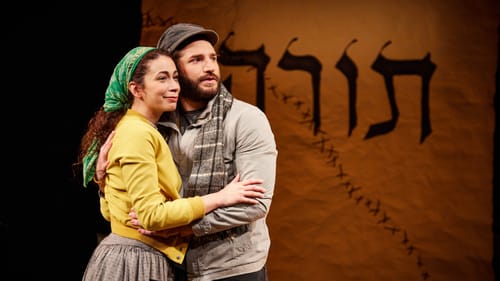Stay in the Loop
BSR publishes on a weekly schedule, with an email newsletter every Wednesday and Thursday morning. There’s no paywall, and subscribing is always free.
The balm of the mamaloshen
National Yiddish Theatre Folksbiene presents Fiddler on the Roof in Yiddish

As I traveled to New York last month to review National Yiddish Theatre Folksbiene’s Fiddler on the Roof in Yiddish, I remembered my first BSR review of Fiddler. It was a touring revival that opened before white supremacists marched through Charlottesville, Virginia, torches in hand, chanting “Jews will not replace us!” I called that production “relevant, contemporary, and powerful,” noting that for many Jewish Americans, the rise of incidents like the Charlottesville rally “shattered our belief that antisemitism was a thing of the past.”
The day after my review was published, a gunman entered the Tree of Life Synagogue in Pittsburgh, killing 11 people and wounding six others. I grew up in a small town two hours east of Pittsburgh and we had gone to community events in Squirrel Hill frequently. My phone started buzzing with friends and family checking in.
My younger child’s B’nai Mitzvah ceremony had been less than a month before at our synagogue here in Philadelphia. I was still bathing in the joy of that beautiful coming-of-age ritual for our child. In the ceremony, before my child read from the Torah scroll, the rabbi had handed the Torah to my parents and my mother-in-law, then to my husband and me, then to our child, embodying the passing of tradition from one generation to the next.
Ok in America?
On the day of the shooting, I couldn’t fathom what must have gone through the minds of the people there in the synagogue. One congregant had survived the Holocaust, only to narrowly escape with his life on a Shabbat morning in Pittsburgh.
I walked my dog later that afternoon around our neighborhood in a daze. I saw an Orthodox Jewish friend of mine, walking to the late-afternoon Shabbat service at the synagogue down the street. She greeted me with Shabbat Shalom and asked how I was doing. She looked happy; I realized that she wouldn’t have had her phone or other media on during the Sabbath. I burst out, not able to contain myself “Oh Joan, you don’t know!” and I spilled out the story of the shooting, taking away her last few hours of Sabbath peace.
Once again, violence shattered illusions about the Jewish community’s safety here in America. A few days later, I went back and reread my Fiddler review, which ends with a description of Tevye’s family preparing to go to the United States. I recounted the words of an older man sitting next to me, who said to his wife, “They’re going to be ok.”
“And yet, in this historic moment of watching refugees from around the world unable to find a haven,” I wrote, “I left the theater feeling much less certain than he did.”

I don’t believe that my words were a premonition. I wrote that conclusion as a Jewish person who was not ignoring the rise in antisemitic incidents around me. I couldn’t have anticipated, though, how utterly dislocating news of the mass murder at the Pittsburgh synagogue would feel.
Fiddler in Yiddish returns
When the National Yiddish Theatre Folksbiene announced the return of its award-winning 2018 production of Fiddler in Yiddish, with English subtitles, I did not want to miss its limited run (through January 1, 2023).
The last few years—and even especially the last month—has been an exhausting period for Jewish Americans, with the rise of antisemitism coming at us from many directions (including celebrities I won’t name here), from social media to banners displayed on highways and in a sports arena, and the campaign of Pennsylvania’s Republican gubernatorial candidate.
When I thought of experiencing Fiddler in Yiddish, the mamaloshen, or the mother-tongue of my ancestors, I imagined that it might be a balm. And I was right.
The Folksbiene’s production, directed by the legendary Joel Grey and starring Steven Skybell as Tevye the Dairyman, is minimalistic in its staging. Rather than an elaborate set design creating the fictional shtetl of Anatevka, a small town set somewhere near Kyiv, the stage is draped in a cloth embroidered with four Hebrew letters that spell Torah, which literally means teaching, and in this case, refers to Fiddler’s opening song, “Tradition.”
Yiddish in the family
Like most American Jews from Gen X, I don’t speak Yiddish. My grandmother Minerva knew it well; her immigrant parents, from a shtetl like Anatevka, spoke Yiddish in the home and my great-grandfather Jacob kept the records for his little corner store all written in Yiddish.
Grandma grew up to be an actor and an English teacher, with impeccable grammar (I had mastered by age four that I may go to the bathroom). But she also sprinkled Yiddish generously into her conversation—especially when she was being silly or funny, which we kids delighted in.
“Oy, yoy, yoy, America…” she would sigh as she read the paper. She would kvell and shlep; people were mishuganah or had too much chutzpah. I would beg her for Yiddish lessons, but like with any language you don’t use, I couldn’t hold on to more than a phrase or two.
A living, breathing language
The Fiddler soundtrack is one that I know in my kishkes (how’s that, Grandma?) I was in a community theater production with my mom and brother when I was in high school and we listened to the soundtrack over and over. (I had one solo of two words: “Why not?” during the dream scene.) I’ve also used excerpts from the movie version while teaching in synagogue schools and have now watched Fiddler with my own children more times than I can count.

I wondered how much of the score in Yiddish that I would be able to comprehend and how much I would need to rely on the English subtitles, shown on a screen on the side of the stage.
It turned out to be some of each. There were many more words and phrases that I understood by watching the actors, knowing what was being said or sung without needing to translate, than I expected.
We don’t know how widely used the Yiddish language would be today if not for the Holocaust: the majority of the six million people murdered by the Nazis were Yiddish speakers.
For me, three hours of Yiddish as a living, breathing language in this beautiful production felt both bittersweet and healing.
Unforgettable theater
I’ve seen a lot of theater over the years, writing as a critic and arts reporter for the last 25 years now (cue “Sunrise, Sunset”). There are about a dozen theatrical productions that I will always remember—and now, I will add the Folksbiene’s Fiddler to that list.
Skybell’s Tevye is a real person, not a caricature, someone struggling in an uncertain world. His portrayal sets the tone, with the talented ensemble bringing his family and the people of Anatevka to life with nuance, humor, and humanity.
Grey makes powerful and profound theatrical choices. At the end of act one, when Tzeitel and Motel’s wedding party ends in a pogrom, it’s not simply that their feather pillows get stomped and ruined. In this production, we hear shots and cries, evoking what we know really took place during those pogroms: rape, beatings, torture, murder.
One of the Russian officers enters the stage, rips the backdrop, tears the fabric that is the Torah in half. It is a visceral metaphor. Sitting with my son, we gasped out loud, along with everyone in the theater.
The house lights rose and we went to stretch our legs and get a soda. I felt shaken, lost between worlds.
A healing metaphor
When we came back in for act two, my son pointed out to me, "The Torah has been sewn.” Indeed, the backdrop, in another powerful metaphor, had been repaired with embroidered stitches. We were ready for what was coming in act two: Tevye’s struggle with his daughters’ independence and the moment when the Jews of Anatevka would be forced to leave their home.

Even though I knew it was coming, I wept as they packed: Tevye and Golde, Yenta the matchmaker and Lazer Wolf; this one headed to Israel, this one to Warsaw, this one to America.
Four years after seeing the first Fiddler production that I reviewed, I hold both more weariness and more resilience, more profound connection to carrying this ancient tradition forward, even as antisemitism continues to rise.
The fiddler in this brilliant production is a young woman, showing how Judaism both holds tradition and evolves into new forms, and she dances and follows Tevye when he flees Anatevka. He does not leave her behind—and she will not leave him alone.
That metaphor, both haunting and reassuring, feels especially right at this moment.
What, When, Where
Fiddler on the Roof in Yiddish. Based on the stories of Sholom Aleichem. Book by Joseph Stein, music by Jerry Bock, lyrics by Sheldon Harnick. Yiddish translation by Shraga Friedman. Directed by Joel Grey. Through January 1, 2023, at New World Stages, 340 W. 50th Street, New York, NY. (800) 447-7400 or nyft.org.
Accessibility
New World Stages has an escalator and elevator to the ground theater level. Restrooms are wheelchair-accessible. Contact the Shubert organization for accessibility questions at (212) 944-3700.
Sign up for our newsletter
All of the week's new articles, all in one place. Sign up for the free weekly BSR newsletters, and don't miss a conversation.

 Gabrielle Kaplan-Mayer
Gabrielle Kaplan-Mayer